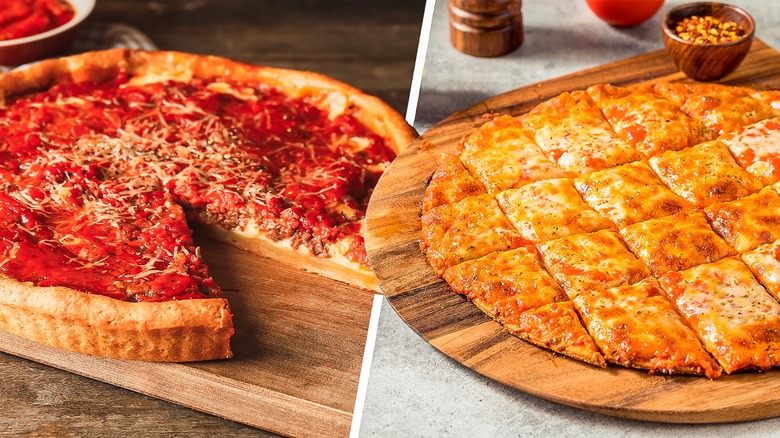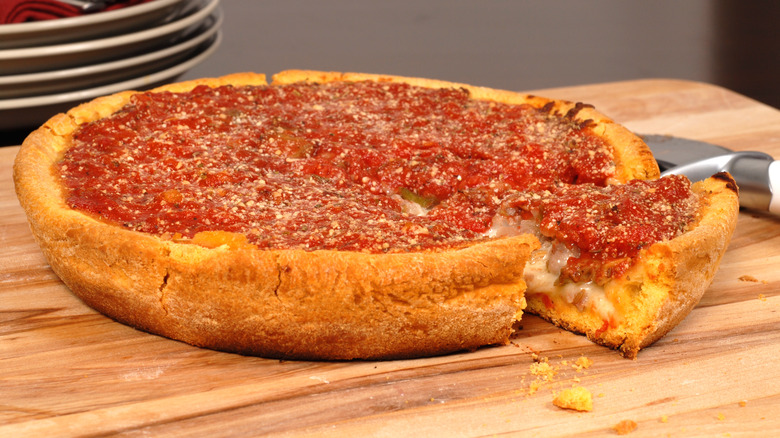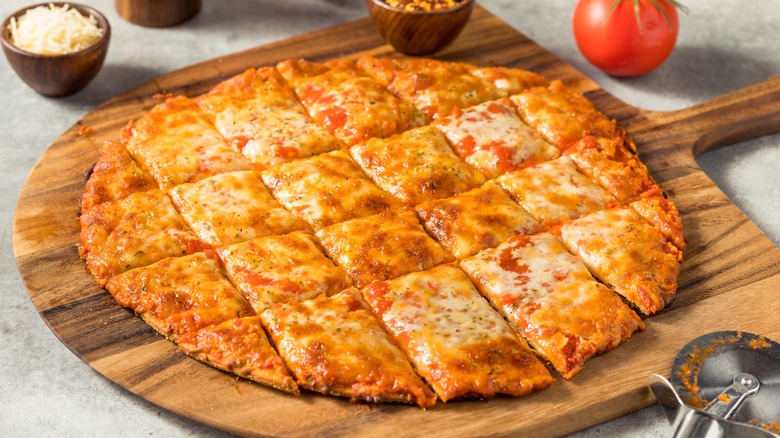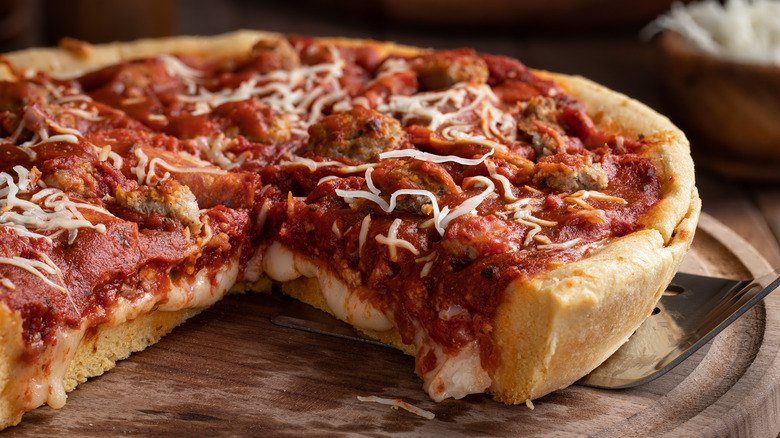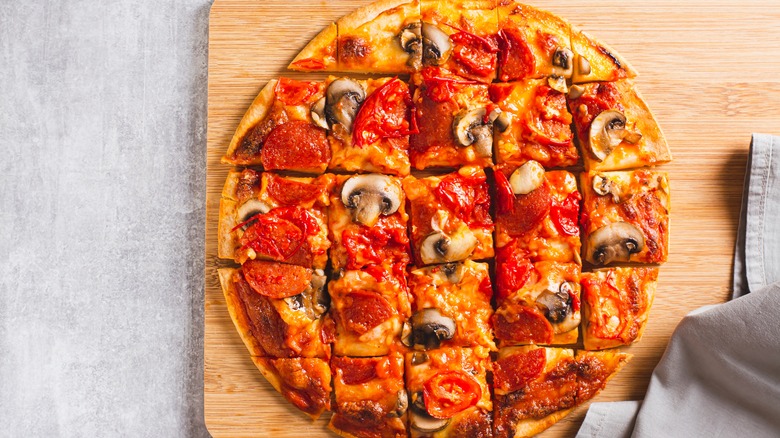What's The Difference Between Chicago Deep Dish And Tavern-Style Pizza?
To the average tourist, deep dish pizza is to Chicago what a Neopolitan-style pie is to Naples. For nearly a century, deep dish has indeed become synonymous with Chicago's signature foods as visitors flock to the city to try the love-it-or-hate-it pizza. Deep dish, however, isn't the Windy City's only — or even most historic — pizza iteration. Rather, thin tavern-style pizza is also a Chicago trademark that likewise characterizes the city's cuisine. This style of pizza is less immediately identifiable than deep dish pizza but no less delicious.
In fact, both deep dish and tavern-style pizzas have been staples across Chicago for quite some time. The former originated in the 1940s, while tavern-style pizza has been around for even longer — since roughly the 1930s. It gained traction in, of course, bars and taverns and continues to crop up across the city's restaurants. Yet despite similar longevities, deep dish and thin-crust, tavern-style pizzas are difficult to compare; they're both pizza, technically, but they look and taste like two separate categories of food entirely. The key differences between the two, then, aren't in their ingredients or flavors so much as they're found in each pizza's structure and texture.
What is Chicago deep dish pizza?
Deep dish pizza tastes — and looks — exactly as its name indicates. It's for this reason that the Chicago deep dish pizza has sparked many a debate about whether it is, technically, pizza. While there isn't any one conclusion, the pizza hovers somewhere between an actual pizza and a savory pie. The crust on a Chicago deep dish is heavy and thick, layered with a mixture of sauce and cheese. It's typically baked in a round pie pan, which helps the crust crisp up along the edges.
Just like any pizza, however, different restaurants embrace different iterations of deep dish. Chicago institution Lou Malnati's, for instance, serves deep dish well done or gooey with various options for toppings. While you can't go wrong with a classic sauce and cheese, the restaurant offers a version with spinach, mushrooms, and tomatoes, as well as one with lean sausage and extra cheese. None of the iterations necessarily lend themselves to grab-and-go slices but are their own entity entirely.
Of course, given the nuances of deep dish, it may not be everyone's pizza of choice. If you prefer your pies with a thinner crust, tavern-style is the better bet. That pizza still embraces the spirit and flavors of Chicago but in a different crust.
What is tavern-style pizza?
Tavern-style pizza may not be the first pizza that comes to mind for Chicago tourists, but locals are no stranger to the pizza type. The style originated when bar owners used to offer free food to drinking patrons but has since become a citywide staple. As for its unique characteristics, tavern-style pizza is defined primarily by its base of ultra-thin and crispy crust. A tavern-style pizza is typically circular but is then cut into small squares, perfect for sharing at a tavern. That style of cutting is a trademark of tavern-style and makes it easy to recognize the pie, even if you've never tried it.
Of course, just like any other style of pizza, tavern-style options can come with an assortment of toppings. You can choose between your favorite flavors, whether you want ricotta cheese or a classic sausage addition. Though no matter how you top it, the cheese goes all the way to the end of each slice — no excessive empty crust here.
And while the pizza originated as a bar food, you can now find it at restaurants all over Chicago and beyond. Pizza Hut even unveiled a tavern-style pizza lineup, with four new thin-curst pizzas. Yet, while tavern-style pizza is surely delicious, it is quite different from deep dish. So if you have to choose between the two, consider your ideal crust texture and just how thick you like your pizza.
Deep dish has a thicker, deeper crust
Given the distinctive nature of both deep dish and tavern-style pizzas, the differences start at the bottom. Each pizza's unique crust defines it and distinguishes one style from another. Take deep dish, where every crust embraces the spirit of an actual pie. Deep dish bases come flaky and tender, thanks in part to the combination of vegetable oil, olive oil, and butter. When making your own deep dish pizza at home, you therefore want to be meticulous and patient in following the right steps.
Tavern-style pizza, meanwhile, hinges on a crust that's as thin as can be. The key to that thin, crispy crust is ultra-dry dough, as well as over-fermented dough. These qualities lend themselves to a pizza that's much crispier than not only deep dish but also New York style or Neapolitan-style pie. It's easy to eat quite a few slices of tavern-style pizza, which are so thin you can enjoy them in just a few bites. For comparison, deep dish is much heavier and more immediately filling. Given these unique textures, deep dish and tavern-style pizzas invite different approaches to eating. The best technique for enjoying each pizza is thanks in part to how they layer sauce and cheese — and just how messy a bite can become.
Tavern-style pizza is eaten with your hands
Perhaps the most obvious difference between deep dish and tavern-style pizza isn't in each version's appearance, texture, or even taste. Rather, the key variance is a matter of technique, which encapsulates each pizza's idiosyncrasies. In general, deep dish requires a fork and knife, as the pizza tends to come layered, ultra-saucy, and messy. This technique extends to the organization structure of the pizza: Deep dish layers cheese, then sauce, embracing a backwards version of a traditional pie. Meanwhile, tavern-style is thin and crispy enough to pick up by hand and is more traditionally structured with sauce, then cheese.
Yet, while deep dish and tavern-style pizzas have carved out unique places in Chicago's cuisine, the city isn't skimping on other forms of pizza. Neapolitan pizza — such as the Neapolitan pies at Millennium Park's Napolita Pizza — is likewise popular in Chicago, as are other Italian and Italian-American dishes. For instance, Chicago is equally known for its spicy giardiniera sauce, so you won't be lacking for foods that combine sauce, cheese, and carbs. When in doubt, grab a slice of both deep dish and thin-crust, tavern-style pizza. Chicago's beloved Gino's East offer both on its menu, and they're so different, it won't feel like you're eating the same food.
